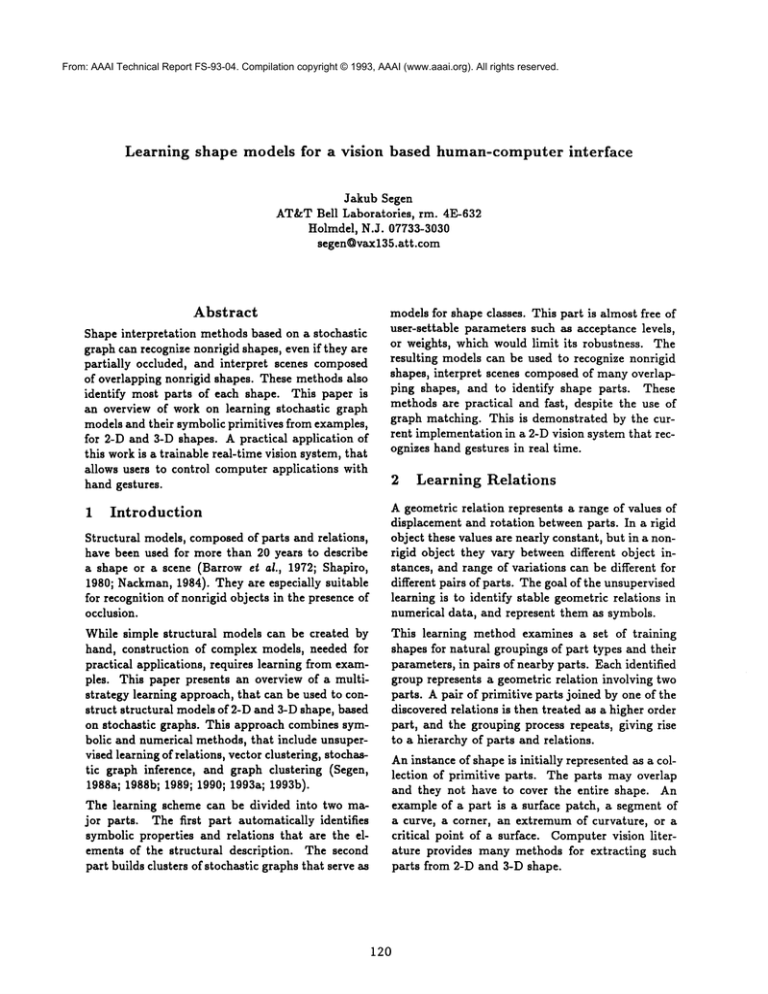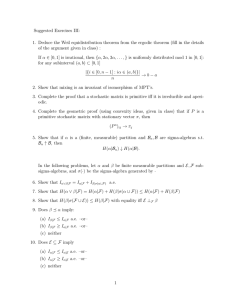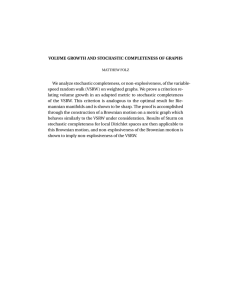
From: AAAI Technical Report FS-93-04. Compilation copyright © 1993, AAAI (www.aaai.org). All rights reserved.
Learning
shape
models
for
a vision
based
human-computer
interface
3akub Segen
AT&TBell Laboratories, rm. 4E-632
Holmdel, N.J. 07733-3030
segen~vax135.att.com
Abstract
Shape interpretation methods based on a stochastic
graph can recognize nonrigid shapes, even if they are
partially occluded, and interpret scenes composed
of overlapping nonrigid shapes. These methods also
identify most parts of each shape. This paper is
an overview of work on learning stochastic graph
models and their symbolic primitives from examples,
for 2-D and 3-D shapes. A practical application of
this work is a trainable real-time vision system, that
allows users to control computer applications with
hand gestures.
1
models for shape classes. This part is almost free of
user-settable parameters such as acceptance levels,
or weights, which would limit its robustness. The
resulting models can be used to recognize nonrigid
shapes, interpret scenes composed of many overlapping shapes, and to identify shape parts. These
methods are practical and fast, despite the use of
graph matching. This is demonstrated by the current implementation in a 2-D vision system that recognizes hand gestures in real time.
2
Learning
Relations
A geometric relation represents a range of values of
displacement and rotation between parts. In a rigid
object these values are nearly constant, but in a nonrigid object they vary between different object instances, and range of variations can be different for
different pairs of parts. The goal of the unsupervised
learning is to identify stable geometric relations in
numerical data, and represent them as symbols.
Introduction
Structural models, composedof parts and relations,
have been used for more than 20 years to describe
a shape or a scene (Barrow eta/., 1972; Shapiro,
1980; Nackman,1984). They are especially suitable
for recognition of nonrigid objects in the presence of
occlusion.
While simple structural models can be created by
hand, construction of complex models, needed for
practical applications, requires learning from examples. This paper presents an overview of a multistrategy learning approach, that can be used to construct structural models of 2-D and 3-D shape, based
on stochastic graphs. This approach combines symbolic and numerical methods, that include unsupervised learning of relations, vector clustering, stochastic graph inference, and graph clustering (Segen,
1988a; 1988b; 1989; 1990; 1993a; 1993b).
The learning scheme can be divided into two major parts. The first part automatically identifies
symbolic properties and relations that are the elements of the structural description.
The second
part builds clusters of stochastic graphs that serve as
This learning method examines a set of training
shapes for natural groupings of part types and their
parameters, in pairs of nearby parts. Each identified
group represents a geometric relation involving two
parts. A pair of primitive parts joined by one of the
discovered relations is then treated as a higher order
part, and the grouping process repeats, giving rise
to a hierarchy of parts and relations.
Aninstance of shape is initially represented as a collection of primitive parts. The parts may overlap
and they not have to cover the entire shape. An
example of a part is a surface patch, a segment of
a curve, a corner, an extremum of curvature, or a
critical point of a surface. Computervision literature provides many methods for extracting such
parts from 2-D and 3-D shape.
120
A primitive
part is represented
by a triple
[type, inv, var], where type is a symbol, inv and var
are real valued vectors, such that ifT is a rigid transformation, then T(p) = [type, inv, T(var)]
The t~/pe specifies the format and interpretation
for inv and vat vectors, and it is used to distinguish parts generated by different extraction methods. The inv vectorcontainsparameters
thatare
invariant
underrigidtransformations
of thecoordinatesystem.
Someparts,
suchas a single
point,
have
no invariant
parameters,
thatis theinvvector
have
dimension
zero.Thevat vectorconsists
of parametersthatchangewithrigidtransformations.
This
vector
carries
information
related
tothepart’s
pose,
thatis part’s
position
andorientation
in space.In
2-Dspaceposeconsists
of threevalues:
twocoordinatesof position
andtheorientation
angle.In 3-D
spaceposehassixdimensions:
threeposition
coordinates
andthreeangles.
If theposeof a partcan
be completely
determined
basedon the formof the
part,thenthevatvector
is thepose.However,
fora
partwithcontinuous
symmetries,
suchas a line,the
posecanonlybe specified
up to a number
of degrees
of freedom.
Forsuchpartsvarcontains
themaximal
numberof parameters
constraining
itspose.
depends
on 8~./mmetry
t~/pes
of thecomponent
parts.
A symmetry
typespecifies
a groupof rigidtransformations
whichdo notchangethepart’sappearance.
Forprimitive
parts,
thesymmetry
typeis a function
of the parttype.The symmetrytypeof a compositepartis determined
by thecomposition
rules.A
composition
operation
for 2-D and 3-D shapeshas
beendescribed
by Segen(1993b).
Thelabelof a primitive
partsymbolically
describes
an invariant
property
(unaryrelation),
suchas size
or curvature.
Thelabelof a composite
partP describes
a binaryrelation
between
itstwocomponent
parts(children).
It alsodescribes
a 4-thorderrelationamongthepart’sgrandchildren
(ifany),8-th
orderrelation
amongthegreatgrandchildren,
andso
forth.The presentimplementation
requires
a compositepartto bc balanced,
so itslabeldescribes
a
2"-ary
relation
overa setof primitive
parts.
Afterconstructing
thecomposite
partsup to a preset
level,
oneretains
onlytheirlabels,
andtheparentchildlinks.Theresulting
structure
is a graphwith
labeled
vertices,
thataregrouped
intolayers
accordingto theirdepth.
Theleaves
of thegraphrepresent
theprimitive
parts;othervertices
represent
compositeparts.Thisgraphcontains
all theinformation
abouttheshape,
thatis usedforrecognition.
In intermediate
formusedforlearning
relations
is
a composite
part.A composite
partis constructed
3 Graph Representations
froma pairof parts(primitive
or composite).
can be described
by a binarytree,wherethe nonA classof graphs
canbe described
usinga probabilleafnodesare composite
parts,andtheleavesare
itymodelwhoseoutcome
is a graph,or a stochastic
primitive
parts.
Depthofthetreeiscalled
a levelof
#raph.Thismodelis represented
by a graphin which
thepart.
everyvertex
is associated
witha probability
distriA composite
partis represented
the sameway as a
bution
overa setoflabels,
rather
thana single
label.
primitive part by a triple [type, inv, var]. Composite A probability
offinding
thelabelI at a vertex
v will
partsareconstructed
bottom-up,
onelevelat a time be denoted
by p(llv
).
up to a presetmaximal
level.At eachleveltheinv
If T is a mapping
fromthevertices
of a stochastic
vectors
of allpartsof thesametypeareclustered,
graphM ontothevertices
of a graphH, oneassigns
andeachpartreceives
thelabelof thenearest
clusto eachmappedvertexof M thelabelof the correter.New composite
partsare formedby applying
a
sponding
vertexof H. The probability
of H, given
composition operation to a pair of already existing
Mand T, P(HIT,M)is the probability of this set
parts.
Theresult
of thisprocess
is a setofclusters
of assignments. Assuming independently distributed
invvectors,
groupedby parttypes.Theseclusters vertex labels, P(HIT,M)is simply the product of
aresaved
in a library,
whichisusedbya shape
recogthe probabilities
where is a vertex of
nitionprogram.
M, and Tv is the vertex of H assigned to v by T.
Thekey element
of theconstruction
process
is the
Inference and interpretation methods using stochascomposition
operation.
The typeof the resultof
composition
is a stringobtained
by concatenating tic graph models are guided by a criterion of minimal
representation (Segen & Sanderson, 1979). This crithe typesof components,
treatedas strings.
The
terion makesuse of an equivalence
betweena most
invandvatvectors
of theresultarecomputed
from
likely
probability
distribution,
anda minimal
length
thevat vectorsof thecomponents.
Thisoperation
programthatgenerates
theobserved
datasequence,
121
among a set of programs for a Turing machine. The
Turing machine is treated here as a general purpose
decoding device, while s program, with a null input,
plays a role of an encoded output sequence. The
resulting inference rule seeks 8 model for a data sequence X, in a form of a probability distribution P
that minimizes
taskinvolves
unsupervised
grouping
of graphs,or
graphclustering.
A simplesupervised
learning
procedure
incrementallyconstructs
a stochastic
graphasfollows.
Given
a sequence of graphs H1, H2, ...H~, the first graph
H1 is converted to a stochastic graph M1, by assigning a prior probability distribution to each vertex.
The remaining graphs are used to update the distric(P)
lo
g (
Px),
butions by a repeated application of a match-andmerge operation, which matches the current model
whereC(P)is thenumberof bitsneededto specify with next graph from the sequence, then uses the
theprobability
modelP, or thecostofP. Thiscrite- vertex mapping to update the label distributions.
rionis equivalent
to theminimal
description
length
A graph clustering task can be defined as a prob(MDL)principle of Rissanen (1978).
lem of minimizing the cost of representing a set of
3.1 Matching graphs
graphs, by forming groups of graphs, encoding group
properties,
and then encoding individual properties
A key mechanism of a learning system based on a
relative
to
group properties. Two graph clustering
graph representation is a method for establishing a
methods
based
on such formulation have been demapping between elements of two graphs, or graph
scribed
in
(Segen,
1990).
matching. The task of matching a stochastic graph
M to a graph H, is formulated as a construction
3.3 Graph interpretation
of a mapping between vertices of M and H, that
Givena graphH anda libraryof stochastic
graph
maximally simplifies description of H, when H is
models
represented relative
to M, and -IogP(H[T,M) is
ML---- {M0,M1, M2, ...M~,~, one may want to select
used as an estimate of the cost of encoding labels of
a
model in ML which is most similar to H. This
mapped vertices of H. This formulation provides a
task
is called recognition. Since the mapping of H
natural decision rule for accepting s match, which
to
a
single
model may not exhaust all the vertices of
does not rely on an arbitrary threshold. Intuitively,
H,
different
subgraphs of H could be mappedto difit works as follows: If part of H matches a part of M,
ferent
models.
These mappings taken together form
then representing H relative to Mshould cost less
an
interpretation
of H. Since recognition and interthan the representation of H based on prior probpretation
can
lead
to a compressed representation
abilities. However,the total cost of representing H
of
H,
both
tasks
can
be formulated as problems of
with the aid of Mincludes an overhead associated
minimizing
the
cost
of
representation. Heuristic sowith specifying the mapping. If the part of H, that
lutions
to
these
problems,
based on graph matching,
is mapped to Mis sinai1, the savings may not cover
have
been
described
in
(Segen,
1990).
the overhead cost, and it is cheaper to use priors,
that is to reject the match. A fast heuristic method
4
Shape Recognition
for graph matching has been described in (Segen,
1988b; 1989).
Given a collection of primitive parts extracted from a
shape or a scene, the recognition programfirst iden3.2 Learning graph models
tifies relations and forms a graph, then finds objects
Given set of shape examples represented as graphs,
andtheirclasses
usinggraphrecognition,
or graph
and their class assignments, the objective of learninterpretation.
ing is to describe each class using stochastic graphs.
Therelations
areidentified
by building
a hierarchy
This task can be approached in two ways. First, a
of composite
partsas in therelation
learning
step,
single stochastic graph can be forced to represent all
but
instead
of
clustering
the
inv
vectors,
each
vector
examples within a class, using a supervised learning
is compared
withthecluster
library
constructed
by
method. However, such a model does not perform
the
learning
step,
and
given
the
label
of
the
nearest
well if the graphs in a class are not sufficiently simcluster.
ilar. In such a case, the class can be divided into
Thegraphrecognition
is preceded
by a modelindexsubclasses consisting of similar graphs, and each subingstep,thatlimitsthenumberof graphmatches.
class can be represented by a stochastic graph. This
122
This step selects several most likely graph models,
using a feature based measure of graph similarity,
that provides an upper bound on the graph matching score.
The final step of the shape recognition program computes the pose of each identified object, based on the
mapping of graph vertices.
5
Applications
The learning and recognition methods have been implemented for a 2-D case in a computer vision system, named GEST, based on one type of a primitive
part: a local extremumof curvature of the boundary
of a planar shape. This part has one invariant parameter: the curvature. The ear vector consists of
the position of the extremal point, and the direction
of the normal vector at this point.
GESTis used as a human-computer interface, that
allows the user to control graphics applications with
hand gestures. It consists of three modules: data
collector, learning module, and a recognizer. Data
collection is an interactive real-time process which
prepares training data for the learning module. In
each interactive step the system prompts the user by
drawing a figure on the screen. The user responds by
presenting a gesture to a camera, trying to match the
location, orientation and deformations of the drawn
figure. The collected data is provided to the learning
module. The learning module is executed off-line. A
typical learning run for 300 training instances takes
about 40 minutes. All the results of learning are collected in a modelfile, that is read by the recognizer.
The recognizer monitors the video input from a camera, attempts to classify any object that appears in
the image, and computes its pose parameters. The
output of the recognizer, that consists of a class symbol and object’s pose, is sent to an application. The
system performs very well recognizing non occluded
gestures. Under occlusion the accuracy drops with
the number of invisible parts. The first version of
GEST’srecognizer (Segen & Dana, 1991) used a network of 30 processors, and processed about 4 video
frames/sec. The current version runs on a Sparc-10,
with a throughput up to 20 frames/sec.
Two sample applications of GESTare described below. In these applications the recognized gesture
class identifies a desired action or command,while
the pose parameters are translated into the command variables, such as position, orientation, or
speed.
Graphics
editor
In the graphics editor the gesture interface replaces
a mouse and a keyboard. Each of the commands
SELECT, MOVE, REVERSE, PLACE, COPY, ROTATE, SCALE,and RESETcorresponds to one of 9
gestures. SELECTpicks the closest object. MOVE
moves the selected object along the line defined by
the index finger. REVERSE
reverses the direction of
motion. PLACEunselects the object and leaves it in
its current position. COPYduplicates the selected
object,
ROTATEturns it clockwise, and SCALE
scales it proportionally to the distance between the
thumb and the index finger. RESETrestores the
initial configuration. Even thought it is not a complete editor, it allows the user to compose complex
scenes using only hand gestures, without touching
any input devices.
Flight
simulator
This application uses five gestures to guide a flight
of a camera through a simulated scene. One of the
gestures controls the azimuth and the elevation of
the flight. Three other gestures are used to control
the speed of the flight, the elevation angle of the
camera, and the height. The fifth gesture brings the
camera to a home position.
6
Conclusion
Wepresented an overview of a two part approach
to learning stochastic graph models for 2-D and 3D shapes. The first part automatically constructs a
symbolic hierarchy of geometric relations. The second part applies the criterion of minimal representation to formulate tasks of graph matching, classification, interpretation, and learning stochastic graph
models as combinatorial optimization problems. Approximate solutions of these problems employan efficient graph matching heuristic. A practical application of the learning and recognition methods in 2-D
is a computer vision system, that recognizes hand
gestures in a real time, and is used as a computer
input device for graphics applications. Weare currently working on a 3-D implementation based on a
structural stereo vision.
References
[1] Barrow, H. G., Ambler, A. P., Bursta11, R. M.
(1972). Sometechniques for recognizing structure in pictures. In S. Watanabe (ed.) Frontier8 of Pattern Recognition, pp. 1-29, Academic Press.
123
[2]Nackman,
L. R. (1984).Two-dimensional
critical pointconfiguration
graphs,IEEETranaaction~ on Pattern Ansl~/sis and Machine Intelligence, PAMI-6, pp. 442-449.
[3] Rissanen, J. (1978). Modeling by shortest data
description. Automatics 14, pp. 465-471.
[4] Segen, J., Sanderson, A. C. (1979). A minimal
representation criterion for clustering. Proceedings of l~ Annual Symposium on Computer Science and Statistics,
Waterloo, Canada.
[5] Segen, J. (1988a). Learning structural descriptions of shape. Machine Vision: Algorithn~s,
Architectures, and Systema, H. Freeman (Ed.),
Academic Press.
[6] Segen, J. (1988b). Learning graph models
shape. Proceedings of the 5-th International
Conference on Machine Learning, pp. 29-35.
Ann Arbor, Michigan.
[7]Segen,
J (1989).
Modellearning
andrecognition
of nonrigid shapes. Proceedings of Conference
on Computer Vision and Pattern Recognition,
pp. 597-602. San Diego, California.
[8] Segen, J.
learning
the 7-th
Learning,
(1990). Graph clustering and model
by data compression. Proceedings of
International Conference on Machine
pp. 93-101. Austin, Texas.
[9] Segen, J. Dana, K. (1991). Parallel symbolic
recognition of deformable shapes. From Pizels
to Features II, H. Burkhardt, Y. Neuvo, J.C.
Simon (Eds.), North-Holland.
[10] Segen, J. (1993a). GEST: A learning computer
vision system that recognizes hand gestures.
Machine Learning IV, R. S. Michalski and G.
Tecuci (Eds.), Morgan Kaufmann.
[11] Segen, J. (1993b). Towards GEST-3D:Learning
relations in 3-D shapes. Second International
Workshop on Multistrategy Learning, Harpers
Ferry, West Virginia.
[12] Shapiro, L. G. (1980). A structural model
shape. IEEE Tran~actiona on Pattern Analysis and Machine Intelligence, PAMI-~, pp. 111126.
124







